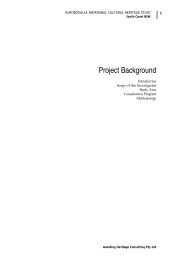Eurobodalla Integrated Water Cycle Management Strategy
Eurobodalla Integrated Water Cycle Management Strategy
Eurobodalla Integrated Water Cycle Management Strategy
You also want an ePaper? Increase the reach of your titles
YUMPU automatically turns print PDFs into web optimized ePapers that Google loves.
188<br />
<strong>Eurobodalla</strong> <strong>Integrated</strong> <strong>Water</strong> <strong>Cycle</strong> <strong>Management</strong> <strong>Strategy</strong><br />
<strong>Water</strong> Infrastructure Performance Issues<br />
<strong>Water</strong> Supply<br />
Narooma town reservoir does not have sufficient capacity to supply future peak day<br />
demands in isolation, however the North Narooma Reservoir has sufficient capacity to<br />
supply both North Narooma and Narooma.<br />
Sewage<br />
Pump stations 4,5,19 are prone to surcharge during power outages and some pump<br />
stations may need upgrading to cope with future growth. The Kianga STP is predicted to<br />
reach its design capacity in 2011. Odour from the pump stations has historically been an<br />
issue. The system has recently been upgraded with biological deodorisation beds, which<br />
appears to have addressed the issue, although the system has not yet undergone a holiday<br />
loading since their construction.<br />
Stormwater<br />
The stormwater generated in Narooma is expected to carry 7.6 tonnes per annum of<br />
nitrogen and 1.20 tonnes per annum of phosphorous. These nutrients have the potential to<br />
affect the health of Wagonga Inlet and the surrounding waterways.<br />
9.12.3 How Do We Fix these Issues?<br />
Overview<br />
There are a number of opportunities to manage the water cycle of the towns of Dalmeny<br />
Kianga and Narooma and the surrounding landscape. The traditional approach to water<br />
management is to separate water, wastewater and stormwater and treat each in isolation.<br />
In this plan, all available opportunities have been identified and coarse screened (see<br />
Appendix C). The coarse screening process recognises that there are immediate and short<br />
term measures, and medium to long term water cycle management opportunities. The<br />
immediate and short term measures need to be implemented as a matter of priority to<br />
achieve legislative compliance and best practice standards. The short-listed medium to<br />
long term water cycle management opportunities would in the long run deliver water cycle<br />
sustainability, public health protection and improved service standards.<br />
Immediate Measures<br />
To reduce the risk of potential overflows one of the following strategies may be employed;<br />
Provide additional storage at the critical pump stations and/or,<br />
Ensuring a more reliable main power supply system or stand-by power.<br />
Short term Measures<br />
The short term measures include:<br />
Expanding the simple data management system into a comprehensive Shire wide<br />
system to record and store operational and performance monitoring information.<br />
Initiating regular and systematic monitoring of operational parameters such as daily<br />
water use, sewage flows, water quality etc and more strategic environmental and<br />
social parameters.<br />
Establishing a water supply reticulation network model to confirm pressure and<br />
firefighting service standards.

















